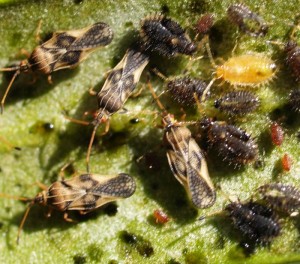Lacebugs are sap-sucking insects that feed on the underside of plant leaves causing a yellow mottling of the leaf surface. This will usually cause the leaf to turn brown and eventually drop off the plant.
The lace bug can have numerous generations per year depending on the climate and species. New infestations can occur regularly throughout the growing season. Eggs that have overwintered on the tree or plant, like azaleas, usually begin to hatch in the spring.
Since lacebugs hide underneath plant leaves, you’ll never notice the bugs. Fortunately it’s easy to see their damage. Lacebug infestations can quickly turn most any plant a faint yellow in color as it’s life’s blood is sucked out.
Lace bugs have an active sex life. They will mate all season long and just a few can produce thousands of offspring in the course of the warm season.
The adult lacebug is barely one fourth inch long. They have many different looks as they grow to adults. This picture shows several stages and what you might see on your plants if you have an active infestation.

Lacebug Control
Spring is a great time to perform lacebug control. Treat them early and you’ll be able to keep them off your plants for the entire season.
Gentle products like Insecticidal Soap will work on lacebugs. But it will have to be applied seveal times during the growing season since it doesn’t provide any long term residual. Bifen will provide much longer residual; a thorough treatment will last 1-2 months on lace bugs. The key to an effective treatment will be making sure the bottom of the plant leaves are sprayed. Insecticidal Soap will do a good job of moving over treated surfaces so large areas will be covered with the application. Bifen should have some Spreader Sticker added to the tank mix to insure good coverage. Merit 75 WP has also proven to be long lasting and is another good product to use. When applied to the soil, it can work it’s way into the plants sap and work as a systemic. This enables the active, imidaclopid, to last many months and effectively stop any insect from feeding on it. Use a good Pump Sprayer to make the application.

Leave a Reply